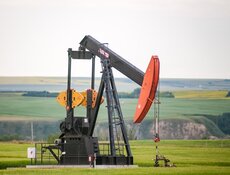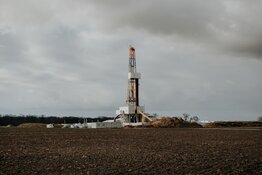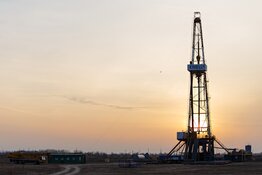Eric Nuttall: We really try to look for opportunities where we have an edge over our competitors. That typically leads us into the small- and mid-cap energy space, where we think the outlook is very positive over the next couple of years. We believe the fundamentals for oil are now very solid. And we think there's been a huge disconnect in the performance of oil and gas (O&G) stocks relative to what the commodities have done.
TER: You're bullish on oil. Tell us why.
EN: What I fall back on is supply and demand data, which I find to be very reliable. Despite an increase in weak economic data points in several developed economies, I still believe that the world oil market will tighten heading into the fourth quarter of this year (Q411). We entered 2011 in a state of being undersupplied by about 1 million barrels of oil per day (MMbpd). So, it wasn't a surprise to me back at the last OPEC meeting that Saudi Arabia was trying to increase actual production by about 1 million barrels. The recent release from the Strategic Petroleum Reserve (SPR) is nothing but a politically motivated move to try to suppress the price. While this may create a ceiling of around $90/bbl for the next several months, demand has been surpassing supply and the market is becoming increasingly tight.
The oil demand story is about emerging economies. China was responsible for 33% of incremental demand in 2010, and in the most recent data from May, demand is up 13% year-over-year (YOY). China now consumes more than 9 MMbpd, a net change of over 1 MMbpd. I'm looking for demand destruction in the developed economies; however, incremental net demand out of China, India and even parts of Africa more than outweighs that demand destruction. The oil market is tight today, and I think that it'll continue to get increasingly so. Today, we consume 89 MMbpd globally; if the world continues to increase demand by roughly 1–2 MMbpd per year, it's very easy to see a scenario in which OPEC spare capacity could get down to 1 MMbpd within the next two years. In that environment, I think the price of oil has to go higher.
TER: When you last spoke to The Energy Report in the fall of 2010, you said that equity valuations—not commodity prices—would be your guide. Since that time, Brent Crude is up about $30/bbl or about 40%. Have you become a bit more commodity-driven since then?
EN: I wouldn't say so. I think Brent is a more relevant benchmark to use than is West Texas Intermediate (WTI) because of the landlocked-storage issues that Cushing, Oklahoma has been experiencing. So, when I look at a $105/bbl Brent price, it tells me that world oil demand is very, very strong. But at the same time, my forte is not top-down analysis of the commodity markets—it's trying to find mispriced stocks. I personally believe that global supply and demand now support a price of approximately $100/bbl WTI, so you could call it about a $110/bbl Brent price. I think that price level is defendable for the next couple of years, with an upward bias toward maybe $5–$10/bbl per year.
In that environment, I think there are some incredibly cheap oil stocks in the sub-$2 billion market-capitalization range that are trading at under 4x enterprise value to cash flow (EV:CF); they are growing production by 30%, 40%, 50% per year and they have very clean balance sheets and a lot of exposure to emerging plays. It's the best of all worlds. You've got dirt-cheap stocks with a tremendous amount of upside. The amount of fear in the marketplace today is the highest I've seen since 2009. One of my best lessons from the Great Recession is that where there's fear, there's opportunity. I think there's a tremendous amount of opportunity in this subset of the market right now.
TER: Then, clearly, you are finding compelling valuations.
EN: Without question.
TER: And we'll get to that, but let me bridge to this. Are you currently bearish on natural gas?
EN: I am. I believe that it's going to be capped at around $5/Mcf (thousand cubic feet). I think we're stuck in a $4–$5/Mcf trading range until 2015, at which time North America will become an exporter of natural gas. In Canada, the Kitimat LNG (liquefied natural gas facility) will be constructed by around 2015. Kitimat is jointly owned by Apache Corp. (NYSE:APA), EOG Resources Inc. (NYSE:EOG) and Encana Corp. (TSX:ECA; NYSE:ECA). In addition, Cheniere Energy Partners L.P. (NYSE.A:CQP) got expanded approval to be a natural gas exporter. I think we're going to see a lot more regasification facilities on the Gulf of Mexico seek approval to become exporters.
Technology has unlocked an unbelievably large amount of natural gas that is now quite economic at low prices. Four or five years ago, I would've said the required price to achieve a decent economic threshold was $7/Mcf. Today, I think that threshold is about a $4–$5/Mcf price among most of the shale plays, which would be Eagle Ford, Haynesville and Marcellus—the largest sources of new supply in both the United States and North America. Rig count has continued to expand in all of those plays. Even in a depressed natural gas price environment, producers continue to drill.
Demand is growing as a result of coal substitution and lower nuclear power plant utilization, but l still think supply is overwhelming demand. Again, until we become an exporter, we're looking at a $5/Mcf ceiling price because if we ever get above that, every single gas company in North America will be trying to hedge to be able to lock in a very active capital-expenditure (capex) program.
TER: So, you're saying there's a real arbitrage opportunity for some nat gas producers to export to Asia and Europe?
EN: Yes, there's a huge arbitrage in that. The global LNG pricing on average has been around $10–$12/MMBtu (million British thermal units). There are times when it spikes due to seasonal factors, but there's a huge price differential. That's why I think the plays that are close to key export terminals are going to become highly strategic. Some of my top holdings are companies involved in what I think will become increasingly strategic areas.
TER: For many reasons, energy has been a natural growth sector. How do investors play this today?
EN: I look for companies in which I think I have an edge in my analysis to determine if they truly are undervalued, or whether they're just value traps. Because we've seen names fall 10%–15% in May, and then by another 15%–20% in June, you could almost throw a dart at a board and make money in the energy sector over the next couple of months. But where I'm finding value, and where I think you get the best risk/reward, is in companies that are levered to oil that are in that sub-$2 billion market-cap space. There are also opportunities in the natural gas space. In a $4–$5/Mcf gas-price environment, some companies are earning about a 75% margin. I'm looking where the risk/reward of an investment opportunity is highly, highly skewed to the upside.
TER: Skewed to the upside. Could you give me an example of that?
EN: Well, we could walk through some of my top holdings. That's probably the best way to understand my style.
TER: Sure.
EN: In terms of size, my largest current position is Legacy Oil & Gas Inc. (TSX:LEG). It's a $2 billion-market cap light oil company, and it's a case study of how we try to look at things differently. There was a management change within a major shareholder, Fidelity Investments, and the manager had to blow out 18 million shares. That took the share price from $17.50 down to around $11.50; not for any fundamental reason—it was due to fund flow. The stock trades at around $12 today, but I was aggressively buying at around $12.50 and was buying every share I could at around $11.50.
When I started buying LEG, I was paying the lowest multiple of price-to-cash flow in its corporate history. and I thought my downside was limited to commodity and market risk. I knew the company had very significant exposure to several emerging plays, including the Spearfish in North Dakota and the Alberta Bakken, which is an emerging tight oil play. So, I paid a very low multiple and got all of the upside free. I could see the stock at $16. So, while a 33% upside from today's level doesn't sound super sexy, it's decent; and I think my downside risk is very low. The company is managed by, in my opinion, one of the best light oil teams in the business, which is comprised of proven value creators; and the balance sheet is very clean.
TER: I note the company went from operations cash flow of $26.3M in Q110 all the way up to $43.9M in Q111. Can that kind of growth continue?
EN: Yes, I'm looking for more than $300M cash flow in 2012. That would put the company at 6.7x cash flow today, and I think it can grow production by 15%. Legacy's about 80% levered to the price of light oil. It's got all of the different aspects I look for.
My second-largest position is Painted Pony Petroleum Ltd. (TSX.V:PPY.A), and this is an example of how you can be bullish on natural gas names without necessarily being bullish on natural gas. The company has a market cap of about $700M and, in terms of production, it's equally split between oil and natural gas. Painted Pony has assets in Saskatchewan, which is typically a light oil-weighted basin, and northwest British Columbia, which is a real upside. But what I really liked is its very clean balance sheet; this is a very debt-averse company. PPY has a five-year drilling inventory in the southeast region of the Saskatchewan Bakken play, where the economics or hurdle rate for the required price of oil is very, very low. When I started buying the stock, it was trading very cheaply on current production. Legacy appears to be in the sweet spot of the Montney Shale play in Canada. I think fair value on existing production is up to $30, but I don't think the company will be around long enough to realize that.
TER: So, 175% upside from here?
EN: Again, I don't think it will be around that long. It could be easily taken out from $17.50–$20/share over the next year or two. Internally, I think fair value is around $20/share. So, I'd be comfortable saying it's close to 100% potential upside.
My third-largest holding is WestFire Energy Ltd. (TSX:WFE), which is almost a pure play on an emerging tight, light oil play called the Viking Formation in Canada. The company has spent several years aggregating acreage in this play, and I believe it has about 800 risked locations. If one believes in $100/bbl oil, then that works out to about $25 of risked value per share—and the stock is trading at $6.85 now and at 3.9x 2011 cash flow. It's very, very cheap on current production. WFE's balance sheet is healthy, and I think production will grow by more than 20% in 2012 over 2011. I like the management; the team members have a lot of their own skin in the game, so they're highly motivated to sell the company when the right time comes.
TER: WestFire was your largest holding at the end of May, was it not?
EN: It would've been a few months ago. I haven't sold any shares. It's been weak relative to a couple of other names.
My fourth-largest holding is a company called Open Range Energy Corp. (TSX:ONR). This is an interesting name because if we had talked nine months ago, I would've told you it was an economic natural gas company that was growing production strongly. But what's really transformed the story is a very positive uptake on a new service business called Poseidon Concepts. It's simply a way to store water that's used to fracture stimulate natural gas wells. What it's created is almost like a very large, inflatable aboveground swimming pool, as opposed to hauling 20 or 25 truckloads of steel tanks. So, there's a cost savings to ONR of more than $100,000 per job.
This business has grown from nothing to a run rate of about $80 million of EBITDA, which is just phenomenal. So, that service business is growing strongly and the free cash flow from it is being used to grow the natural gas business in the Wilrich, where there's phenomenal natural gas economics. The company has very strong growth on the natural gas business and, at the same time, there's very good uptake on the service business. And, it's dirt cheap.
TER: You're a real value seeker, aren't you?
EN: Well, it's important to distinguish between a value stock and a value trap. A value stock can be a cheap stock with no catalyst to revalue the company. I always look for names where I think my downside's limited because it's trading at a cheap multiple based on current production. At the same time, there has to be some catalyst to the name—otherwise, the stock can languish at a cheap multiple for years. Sometimes cheap stocks are cheap for a reason; my job is to try to find those opportunities where, in my opinion, the market is looking at something incorrectly.
TER: You were going to mention another one?
EN: After Open Range would be Bankers Petroleum Ltd. (TSX:BNK). It's fallen from a high of $10 around the beginning of March to near $7, and so the stock's down 30%. At the same time, it's marked off of Brent oil, and it's developing the largest onshore oil field in Eastern Europe, the Patos-Marinza field in Albania. Bankers is producing around 12,000 bpd, and will be exiting at around 18,000–20,000 bpd at the end of this year. It's been very successful at employing Canadian technology in an old field to rehabilitate it and to grow production, primarily using horizontal wells with good success.
TER: Again, it's under a $2 billion market cap, which is where you're comfortable.
EN: Yes, it's that sweet spot. Larger companies are very difficult. With a Suncor Energy Inc. (TSX.V:SU; NYSE:SU) or an Encana, which is a $40–$50 billion market-cap company, it would be very difficult for me to have an edge over my competitors. If I buy that company, I should expect to do as well as the index. My unit holders are not paying me to perform as the index would. They're looking for me to beat it. I'm looking for opportunities in which I've got edge and that will typically lead me to a sub-$2 billion market.
TER: Do you want to mention one more company?
EN: Another one would be Vero Energy Inc. (TSX:VRO), which is a stock that's kind of fallen out of favor with the marketplace. The management's done a very good job of growing production over the years. On a production-per-share basis, it's upward of around 22% from 2009 until now, yet it trades at a low multiple. VRO's trading sub-4x EV to cash flow, despite management's pretty good execution. Production is growing very meaningfully, and the company is increasing the component of liquids in the production stream. My hope is that Vero will sell itself at some point this year or merge with another company creating a high dividend-paying corporation and one exploration entity that the Vero management team could lead.
TER: Eric, these are very interesting names. Thank you very much.
EN: Thank you.
Eric Nuttall is a portfolio manager with Sprott Asset Management (SAM). He joined the firm in February 2003 as a research associate and was subsequently promoted to research analyst in 2005, associate portfolio manager in 2008, and then to portfolio manager in January 2010. Eric is lead portfolio manager of the Sprott Energy Fund, along with Eric Sprott, and he also comanages the Sprott 2010 Flow-Through Limited Partnership with Allan Jacobs. In addition to his responsibilities for those funds, Eric supports the rest of the Sprott portfolio management team in identifying top-performing oil and gas investment opportunities. Eric also contributes to internal macro-energy forecasts, and his insight into emerging unconventional plays has been covered in several financial publications, such as The Wall Street Journal, Asia and Barron's. Eric graduated with high honors from Carleton University with an Honors B.S. in international business.
Want to read more exclusive Energy Report interviews like this? Sign up for our free e-newsletter, and you'll learn when new articles have been published. To see a list of recent interviews with industry analysts and commentators, visit our Exclusive Interviews page.
DISCLOSURE:
1) George Mack of The Energy Report conducted this interview. He personally and/or his family own shares of the following companies mentioned in this interview: None.
2) The following companies mentioned in the interview are sponsors of The Energy Report: None.
3) Eric Nuttall: I personally and/or my family own shares of the following companies mentioned in this interview: Painted Pony, Westfire, Bankers and Open Range. I personally and/or my family am paid by the following companies mentioned in this interview: None.








































